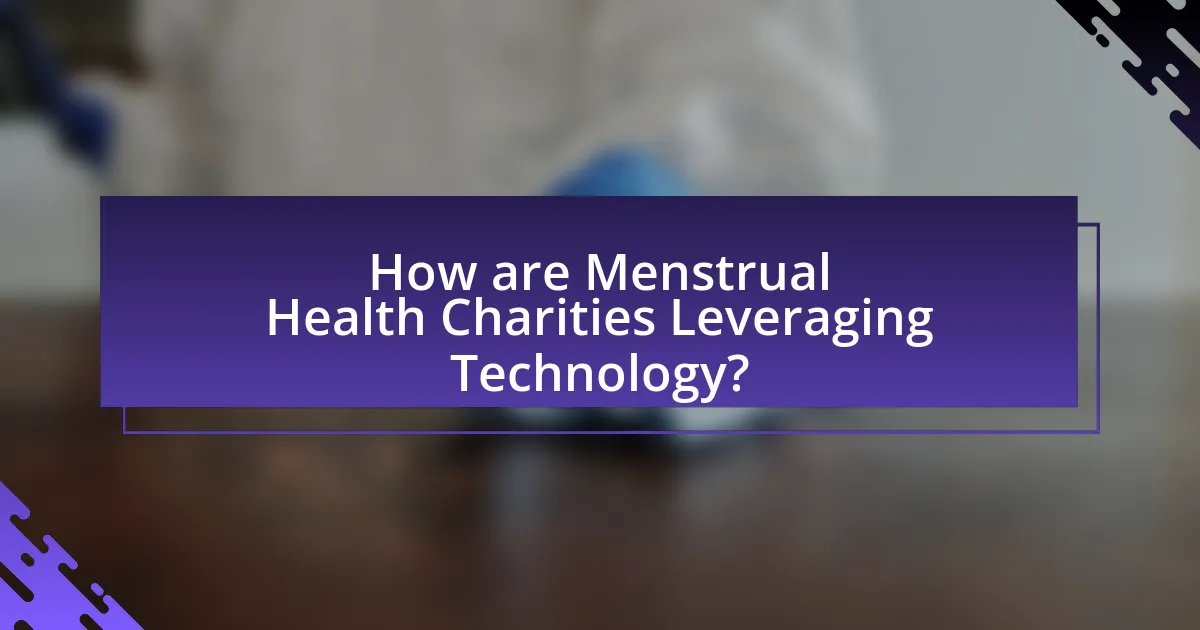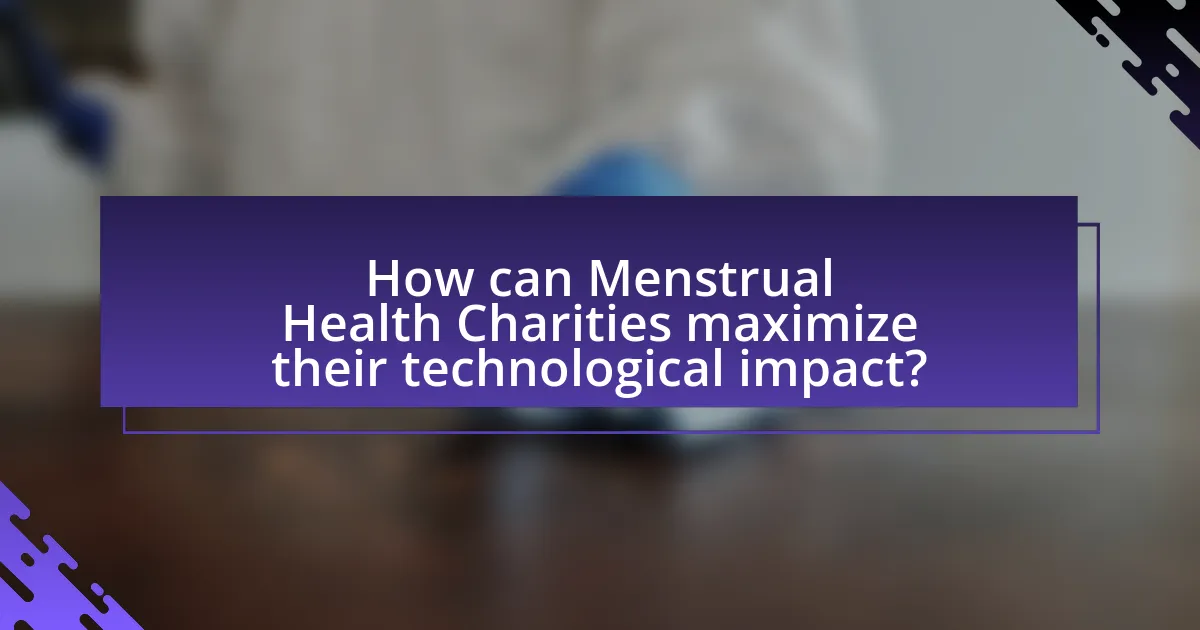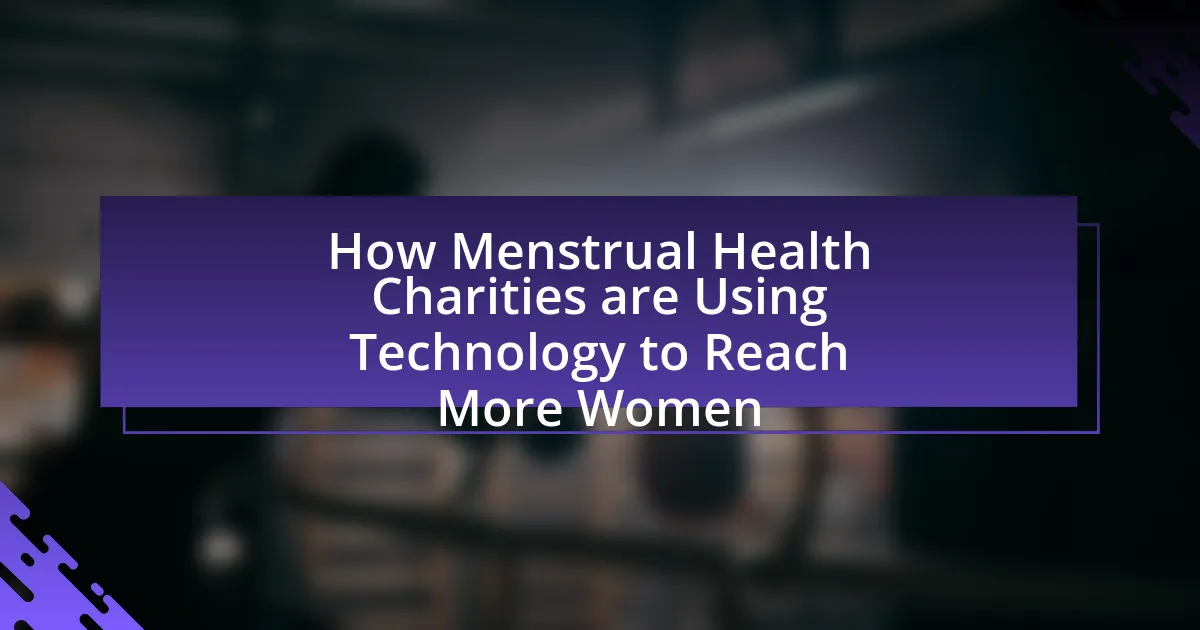Menstrual health charities are increasingly utilizing technology to enhance awareness and access to menstrual health resources. This article explores how these organizations leverage mobile applications, social media platforms, and data analytics to educate women, destigmatize menstruation, and tailor outreach efforts to underserved populations. It also addresses the challenges faced in technology adoption, including limited access and digital literacy, while highlighting best practices for maximizing technological impact. Additionally, the article discusses future trends, such as artificial intelligence and telehealth, that could further improve access to menstrual health services.

How are Menstrual Health Charities Leveraging Technology?
Menstrual health charities are leveraging technology by utilizing mobile applications, social media platforms, and data analytics to enhance awareness and access to menstrual health resources. For instance, charities like Period and Days for Girls use mobile apps to provide educational content and connect users with local resources, while social media campaigns raise awareness and destigmatize menstruation. Additionally, data analytics helps these organizations identify underserved populations and tailor their outreach efforts effectively, ensuring that support reaches those in need. This strategic use of technology not only broadens their reach but also fosters community engagement and empowerment around menstrual health issues.
What types of technology are being utilized by these charities?
Menstrual health charities are utilizing mobile applications, social media platforms, and data analytics tools to enhance their outreach and effectiveness. Mobile applications provide women with information on menstrual health, tracking cycles, and accessing resources, while social media platforms facilitate community engagement and awareness campaigns. Data analytics tools help these charities assess the impact of their programs and tailor their services to meet the specific needs of women in various regions.
How do mobile applications enhance menstrual health awareness?
Mobile applications enhance menstrual health awareness by providing accessible information, tracking tools, and community support. These applications allow users to monitor their menstrual cycles, symptoms, and overall reproductive health, which fosters a better understanding of their bodies. For instance, studies show that apps like Clue and Flo have millions of users who benefit from personalized insights and educational content, leading to increased health literacy. Furthermore, these platforms often include features that connect users with healthcare professionals and support groups, facilitating discussions around menstrual health and breaking stigmas. This combination of tracking, education, and community engagement significantly contributes to raising awareness and promoting informed health choices among users.
What role do social media platforms play in outreach efforts?
Social media platforms serve as critical tools for outreach efforts by enabling menstrual health charities to connect with a broader audience efficiently. These platforms facilitate targeted communication, allowing organizations to disseminate information, raise awareness, and engage with communities directly. For instance, a study by the Pew Research Center indicates that 69% of adults in the U.S. use social media, providing charities with a vast potential audience to reach. Additionally, social media allows for real-time interaction, fostering community support and dialogue around menstrual health issues, which can lead to increased advocacy and resource sharing.
Why is technology important for menstrual health charities?
Technology is important for menstrual health charities because it enhances outreach, education, and resource distribution. By utilizing digital platforms, charities can effectively disseminate information about menstrual health, breaking down stigma and increasing awareness among diverse populations. For instance, mobile applications can provide personalized menstrual tracking and health education, reaching women in remote areas where traditional resources may be limited. Additionally, data analytics can help charities identify specific needs and tailor their programs accordingly, ensuring that interventions are both relevant and impactful. This strategic use of technology ultimately leads to improved health outcomes and greater empowerment for women.
How does technology improve access to menstrual health resources?
Technology improves access to menstrual health resources by providing digital platforms that facilitate information dissemination, product distribution, and community support. Mobile applications and websites enable users to access educational content about menstrual health, track their cycles, and receive personalized advice. For instance, apps like Clue and Flo offer tailored insights and reminders, enhancing user engagement and awareness. Additionally, e-commerce platforms allow for discreet purchasing of menstrual products, which can be crucial in regions where stigma exists. A study by the World Health Organization indicates that digital health interventions can significantly increase knowledge and access to health resources, demonstrating the effectiveness of technology in bridging gaps in menstrual health services.
What impact does technology have on community engagement?
Technology significantly enhances community engagement by facilitating communication, increasing accessibility, and fostering collaboration among individuals and organizations. For instance, social media platforms enable menstrual health charities to reach a broader audience, allowing them to share information, resources, and support quickly and effectively. A study by Pew Research Center indicates that 69% of adults in the U.S. use social media, which demonstrates its potential as a tool for outreach and engagement. Additionally, mobile applications and online forums provide safe spaces for women to discuss menstrual health issues, thereby promoting community support and awareness. These technological advancements create opportunities for real-time feedback and interaction, ultimately strengthening community ties and involvement in health initiatives.

What challenges do Menstrual Health Charities face in using technology?
Menstrual health charities face significant challenges in using technology, primarily due to limited access to digital resources and varying levels of digital literacy among target populations. Many communities lack reliable internet connectivity, which hinders the effective dissemination of information and services. Additionally, cultural stigmas surrounding menstruation can impede the acceptance and use of technological solutions, as individuals may be reluctant to engage with digital platforms that address menstrual health. Furthermore, funding constraints often limit the ability of these charities to invest in advanced technological tools and training programs, which are essential for maximizing outreach and impact.
How do funding and resources affect technological implementation?
Funding and resources significantly influence technological implementation by determining the scope, scale, and effectiveness of initiatives. Adequate funding allows organizations to invest in advanced technologies, hire skilled personnel, and conduct necessary research, which enhances the overall quality of technological solutions. For instance, menstrual health charities that secure substantial grants can develop mobile applications or digital platforms that effectively disseminate information and resources to women, thereby improving outreach and engagement. A study by the Global Fund for Women highlights that organizations with robust financial backing are more likely to adopt innovative technologies that address specific health needs, ultimately leading to better health outcomes for women.
What are the barriers to technology adoption in underserved communities?
Barriers to technology adoption in underserved communities include limited access to infrastructure, lack of digital literacy, and financial constraints. Limited access to reliable internet and electricity hinders the ability to utilize technology effectively. Additionally, many individuals in these communities may lack the necessary skills to navigate digital platforms, which further impedes adoption. Financial constraints also play a significant role, as the cost of devices and internet services can be prohibitive. According to a report by the Pew Research Center, 25% of adults in low-income households do not own a smartphone, highlighting the financial barrier to technology access.
How can charities overcome technological literacy issues?
Charities can overcome technological literacy issues by implementing targeted training programs for staff and volunteers. These programs should focus on essential digital skills, such as using social media, managing databases, and utilizing online fundraising platforms. Research indicates that organizations that invest in training see a 30% increase in digital engagement, which enhances their outreach efforts. Additionally, partnering with tech-savvy organizations can provide charities with the necessary resources and expertise to improve their technological capabilities.
What ethical considerations arise from using technology in menstrual health?
The ethical considerations arising from using technology in menstrual health include privacy concerns, data security, and equitable access to resources. Privacy concerns stem from the sensitive nature of menstrual health data, which can lead to potential misuse if not adequately protected. Data security is critical, as breaches can expose personal information, impacting individuals’ trust in technology. Additionally, equitable access is essential; disparities in technology access can exacerbate existing inequalities, leaving marginalized groups without necessary resources. These considerations highlight the need for responsible practices in the development and implementation of menstrual health technologies.
How do privacy concerns impact the use of health data?
Privacy concerns significantly limit the use of health data by creating barriers to data sharing and utilization. These concerns arise from the potential misuse of sensitive information, leading to a lack of trust among individuals regarding how their health data will be handled. For instance, a survey by the Pew Research Center found that 60% of Americans feel uneasy about how their health data is collected and used by companies. This apprehension can result in individuals being less willing to share their health information, which is crucial for research and the development of targeted health interventions, particularly in areas like menstrual health. Consequently, charities focused on menstrual health may face challenges in accessing comprehensive data that could enhance their outreach and effectiveness.
What measures can be taken to ensure user data protection?
To ensure user data protection, organizations must implement robust encryption methods for data storage and transmission. Encryption secures sensitive information by converting it into a coded format that can only be accessed by authorized users, thereby reducing the risk of data breaches. According to a report by the Ponemon Institute, organizations that employ encryption experience 50% fewer data breaches compared to those that do not. Additionally, regular security audits and compliance with data protection regulations, such as GDPR, further enhance user data protection by identifying vulnerabilities and ensuring adherence to best practices.

How can Menstrual Health Charities maximize their technological impact?
Menstrual health charities can maximize their technological impact by leveraging data analytics and mobile applications to enhance outreach and education. By utilizing data analytics, these charities can identify specific community needs and tailor their programs accordingly, ensuring that resources are allocated effectively. For instance, a study by the World Health Organization indicates that targeted health interventions can improve health outcomes by up to 30%. Additionally, mobile applications can facilitate access to menstrual health information and resources, reaching women in remote areas where traditional outreach may be limited. The use of technology in this manner not only increases awareness but also empowers women to manage their menstrual health more effectively.
What best practices should charities follow when implementing technology?
Charities should prioritize user-centered design when implementing technology to ensure that solutions effectively meet the needs of their target audience. This involves conducting thorough research to understand the specific challenges faced by women regarding menstrual health, which can lead to the development of tailored digital platforms or applications. For instance, menstrual health charities that have successfully utilized technology often engage with their beneficiaries through surveys and focus groups, allowing them to gather valuable insights that inform the design process. Additionally, charities should ensure data privacy and security, as protecting sensitive information is crucial for maintaining trust with users. Implementing robust cybersecurity measures and adhering to data protection regulations, such as GDPR, can safeguard user data. Furthermore, ongoing training and support for staff and volunteers in using new technologies can enhance operational efficiency and service delivery. Evidence from organizations like the Menstrual Health Hub shows that these practices lead to increased engagement and improved outcomes in reaching women effectively.
How can partnerships enhance technological outreach efforts?
Partnerships can enhance technological outreach efforts by leveraging combined resources, expertise, and networks to reach a broader audience. For instance, menstrual health charities collaborating with tech companies can utilize advanced communication platforms and data analytics to effectively disseminate information and services. A study by the World Health Organization highlights that partnerships in health initiatives can increase program reach by up to 50%, demonstrating the tangible benefits of collaborative efforts in expanding outreach capabilities.
What strategies can be employed to evaluate the effectiveness of technology use?
To evaluate the effectiveness of technology use in menstrual health charities, strategies such as user feedback collection, data analytics, and outcome measurement can be employed. User feedback collection involves surveys and interviews to gather insights from women using the technology, ensuring that their experiences and needs are addressed. Data analytics can track engagement metrics, such as app usage frequency and user retention rates, providing quantitative evidence of technology impact. Outcome measurement assesses changes in health knowledge, access to resources, and overall health outcomes among users, which can be compared before and after technology implementation. These strategies collectively provide a comprehensive evaluation framework, ensuring that the technology effectively meets the needs of women in menstrual health initiatives.
What future trends in technology could benefit menstrual health charities?
Future trends in technology that could benefit menstrual health charities include the use of artificial intelligence (AI) for personalized health insights and telehealth platforms for remote consultations. AI can analyze menstrual health data to provide tailored recommendations, improving individual health management. Telehealth platforms enable charities to reach underserved populations, offering education and support without geographical barriers. According to a report by the World Health Organization, telemedicine can increase access to healthcare services, particularly in rural areas, thereby enhancing the effectiveness of menstrual health initiatives.
How might artificial intelligence shape menstrual health initiatives?
Artificial intelligence can significantly shape menstrual health initiatives by enhancing data analysis, personalizing health recommendations, and improving access to information. AI algorithms can analyze large datasets to identify trends in menstrual health, enabling organizations to tailor initiatives based on specific community needs. For instance, AI-driven chatbots can provide personalized advice and support, making menstrual health information more accessible to women in underserved areas. Additionally, AI can facilitate predictive analytics, helping organizations anticipate health issues and allocate resources more effectively. These applications demonstrate how AI can transform menstrual health initiatives into more responsive and effective programs.
What emerging technologies hold promise for improving menstrual health access?
Emerging technologies that hold promise for improving menstrual health access include mobile health applications, telemedicine platforms, and menstrual tracking devices. Mobile health applications facilitate education and awareness by providing information on menstrual health, while telemedicine platforms enable remote consultations with healthcare professionals, increasing access to expert advice. Menstrual tracking devices, such as smart wearables, offer personalized insights and data, empowering individuals to manage their menstrual health effectively. These technologies collectively enhance accessibility, education, and management of menstrual health, addressing barriers faced by women globally.
What practical steps can charities take to improve their technological outreach?
Charities can improve their technological outreach by implementing targeted digital marketing strategies, utilizing social media platforms, and investing in user-friendly websites. Targeted digital marketing allows charities to reach specific demographics effectively; for instance, menstrual health charities can use data analytics to identify and engage with women in need of their services. Social media platforms, such as Instagram and Facebook, enable charities to share educational content and connect with their audience in real-time, fostering community engagement. Additionally, a user-friendly website enhances accessibility, ensuring that information about menstrual health resources is easily navigable, which is crucial for reaching a broader audience. According to a report by the Charitable Giving Report, organizations that actively engage in digital outreach see a 30% increase in donor engagement and community participation.



